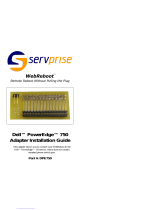Back to Contents Page
Introduction
Dell™PowerEdge™750SystemsInstallationandTroubleshootingGuide
Other Documents You May Need
Obtaining Technical Assistance
Your system includes the following significant service and upgrade features:
l System diagnostics, which checks for hardware problems (if the system can boot)
The following system upgrade options are available:
l Processor
l Memory
l PCI expansion card
Other Documents You May Need
l The Rack Installation Guide or Rack Installation Instructions included with your rack solution describes how to install your system into a rack.
l The Getting Started Guide provides an overview of initially setting up your system.
l The User's Guide provides information about system features and technical specifications.
l Systems management software documentation describes the features, requirements, installation, and basic operation of the software.
l Operating system documentation describes how to install (if necessary), configure, and use the operating system software.
l Documentation for any components you purchased separately provides information to configure and install these options.
l Updates are sometimes included with the system to describe changes to the system, software, and/or documentation.
l Release notes or readme files may be included to provide last-minute updates to the system or documentation or advanced technical reference material
intended for experienced users or technicians.
Obtaining Technical Assistance
If you do not understand a procedure in this guide or if the system does not perform as expected, see "Getting Help."
Dell Enterprise Training and Certification is available; see www.dell.com/training for more information. This service may not be offered in all locations.
Back to Contents Page




















